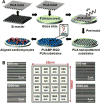Nanotopography-Induced Structural Anisotropy and Sarcomere Development in Human Cardiomyocytes Derived from Induced Pluripotent Stem Cells
- PMID: 26866596
- PMCID: PMC5681855
- DOI: 10.1021/acsami.5b11671
Nanotopography-Induced Structural Anisotropy and Sarcomere Development in Human Cardiomyocytes Derived from Induced Pluripotent Stem Cells
Abstract
Understanding the phenotypic development of human induced pluripotent stem cell-derived cardiomyocytes (hiPSC-CMs) is a prerequisite to advancing regenerative cardiac therapy, disease modeling, and drug screening applications. Lack of consistent hiPSC-CM in vitro data can be largely attributed to the inability of conventional culture methods to mimic the structural, biochemical, and mechanical aspects of the myocardial niche accurately. Here, we present a nanogrid culture array comprised of nanogrooved topographies, with groove widths ranging from 350 to 2000 nm, to study the effect of different nanoscale structures on the structural development of hiPSC-CMs in vitro. Nanotopographies were designed to have a biomimetic interface, based on observations of the oriented myocardial extracellular matrix (ECM) fibers found in vivo. Nanotopographic substrates were integrated with a self-assembling chimeric peptide containing the Arg-Gly-Asp (RGD) cell adhesion motif. Using this platform, cell adhesion to peptide-coated substrates was found to be comparable to that of conventional fibronectin-coated surfaces. Cardiomyocyte organization and structural development were found to be dependent on the nanotopographical feature size in a biphasic manner, with improved development achieved on grooves in the 700-1000 nm range. These findings highlight the capability of surface-functionalized, bioinspired substrates to influence cardiomyocyte development, and the capacity for such platforms to serve as a versatile assay for investigating the role of topographical guidance cues on cell behavior. Such substrates could potentially create more physiologically relevant in vitro cardiac tissues for future drug screening and disease modeling studies.
Keywords: biomimetic surface; cardiomyocytes; chimeric self-assembling peptide; human induced pluripotent stem cells; nanotopography.
Conflict of interest statement
The authors declare the following competing financial interest(s): D.H. Kim is a co-founder and scientific board member of a start-up company, NanoSurface Biomedical, that aims to commercialize nanopatterned polymeric cultureware.
Figures





References
-
- Liu WH, Chang YL, Lo WL, Li HY, Hsiao CW, Peng CH, Chiou SH, Ma HI, Chen SJ. Human Induced Pluripotent Stem Cell and Nanotechnology-Based Therapeutics. Cell Transplant. 2015;24:2185–2195. - PubMed
-
- Lancaster MA, Knoblich JA. Organogenesis in a Dish: Modeling Development and Disease Using Organoid Technologies. Science. 2014;345:1247125. - PubMed
Publication types
MeSH terms
Substances
Grants and funding
LinkOut - more resources
Full Text Sources
Other Literature Sources

